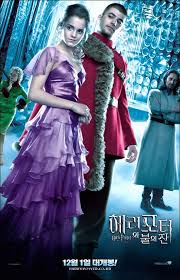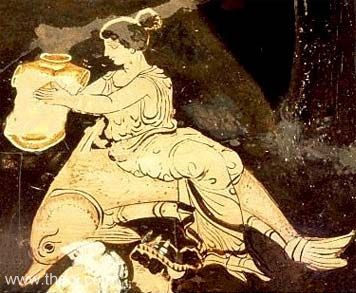
Well, as I’ve said many times, this is my favourite Harry Potter movie. There’s so much good stuff here – Eric Sykes! Doctor Who! Ginny getting plenty of screentime even when she has few lines! The random new people from Prisoner of Azkaban disappearing! Robert Pattinson! (much more attractive here than in Twilight, though rather too young for me even back then). Viktor Krum! Evil mermaids! Ralph Fiennes! Magic tents! A Christmas Ball! And a beautiful, sweeping score from Patrick Doyle.
This is also, of course, the pivotal book and the point at which the series starts to grow up. I think the moment where Harry weeps over Cedric’s body is quite possibly the best bit of acting Daniel Radcliffe has done for the series and the scene is played out with a fantastic intensity. The whole final section with the maze has a much more intense feel to it than Potter has had so far; I’m particularly impressed by Harry and Cedric’s desperate race for the trophy. The decision to put that slightly off, far too cheerful fanfare over Harry’s return was a stroke of evil genius and George from Drop the Dead Donkey will break your heart. Then, of course, there’s the graveyard scene, the creepiest, most terrifying and best scene from all the books and so far, from the movies as well (though Harry’s possession by Voldemort at the end of Order of the Phoenix gives it a run for its money). 'I want to see the light leave your eyes' gives me the chills every time.
The decision to make Beauxbatons and Durmstrang single sex schools works brilliantly, as it gives each school a really strong identity and makes for a very impressive entrance. It is a bit unfortunate that, since this means that the only female Champion came from a school with no boys, it does rather imply that boys make better Champions (and it doesn’t help that Fleur is, let’s face it, kinda wet and a bit rubbish). The selection of the Champions itself, though, includes another wonderfully done moment where Snape notices something’s wrong with the Goblet before anyone else.
Unfortunately for me, with the removal of the sphinx from the book (a very wise decision, and it would have thoroughly ruined the pacing during that crucial maze section) there’s very little particularly ancient or Classical in this movie, beyond the usual Latin spells (periculum is from the Latin for danger). So, um, I shouldn’t really be blogging it. But I’m nothing if not a completist and I didn’t want to leave out my favourite of the movies!
There is one ancient element in the film – the mermaids. Mermaids are not particularly big in Classical mythology, though they do crop up. Modern representations of the Sirens from the Odyssey sometimes picture them as mermaids, but in ancient art the Sirens are usually half woman, half bird and in the Odyssey, there’s nothing to suggest they aren’t simply women. The Assyrian goddess Atargatis, for various reasons, ended up half woman and half fish and Lucian still knew of this story in the second century AD. Aelian describes some sea monsters in the Indian Ocean that sometimes have the faces of women, with spines for hair – these sound the most similar to the film's freaky-looking mermaids than most. The Nereids, sea nymphs led by Thetis, were also sometimes depicted in mermaid form, though oddly enough it is rarely suggested that Achilles’ mother herself was half fish! The word ‘mermaid’ is Anglo-Saxon (‘sea-woman’) and I suspect that the modern view of mermaids, as
 attractive half-naked young ladies given to singing to sailors, is a later development (I don’t know how far back the identification of the Sirens with mermaids goes, but that may have had an effect on the development of mermaid folklore).
attractive half-naked young ladies given to singing to sailors, is a later development (I don’t know how far back the identification of the Sirens with mermaids goes, but that may have had an effect on the development of mermaid folklore).Nereid nymph riding dolphin, Apulian red-figure pelike. C5th B.C., J. Paul Getty Museum, Malibu. From www.theoi.com. This one has feet, but there's a mermaid-like look to the way she's sitting...
I love the interpretation of mermaids here. The friendly Narnian mermaids were based, in their fishy part, on dolphins, but these rather more ambiguous mermaids are based on sharks. They are not exactly evil creatures as far as the story is concerned, but they are pretty nasty and the really ugly look they’ve been given, complete with quite the attitude, always makes me think of them as the Evil Mermaids. Best of all is the contrast between these ‘real’ mermaids with the stained-glass window mermaid in the Prefects’ Bathroom (another nice touch, giving the usual moving portraits a fresh visual spin). The stained glass mermaid, the film suggests, is pure folklore; beautiful, elegant, obsessed with arranging her hair despite living under water. If mermaids really exist, it is implied, they are dangerous wild animals, not naked seductresses.
Dragons are pretty ancient as well of course, though these dragons owe more to Norse and Anglo-Saxon tradition (I would have loved to have seen the Chinese Fireball realized, but we don’t even see the miniature – it doesn’t sound like it has the good nature of ancient Eastern dragons, but maybe it looked like them?). The word is Greco-Roman (Greek drakon, Latin draco) but back then it meant any very big snake, and Greco-Roman mythology is much more interested in snakes, which crop up in all sorts of contexts, than in the sort of giant lizard that is usually pictured in the West when you hear the word ‘dragon’.

I’d better stop there, as I could go on about why I love Goblet of Fire all day. Though I could live without the mental images that always spring to mind when Cedric tells Harry about the bathroom and looks like he’s propositioning him…
Alas, poor Cedric.




No comments:
Post a Comment